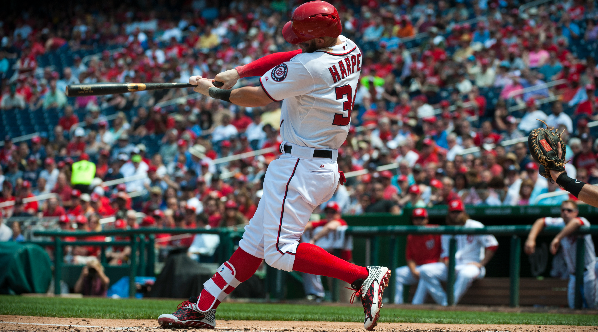It’s once again time to rank the NL East, position by position, and determine before the summer even starts who will win the division. As always with this annual post, there is a musical theme to accompany our analysis. This year we are going with Supergroups, in honor of what I can only hope will be a Nats season fondly recalled as the very same thing. Arguments over how super each group is aside, I went with accomplished/known artists joining together to form a band or group outside of what got them acknowledged in the first place. And no one-song collaborations. Sorry if I didn’t include your favorite 90s alt-rock moderately known heroes, or what not.
The rules here are firmly entrenched: If a team has the #1 player at a position, they get 5 points for it. If they have the worst, they get 1 point. At some point I have to make judgments about the depth chart, so I used the roster I expect to see for at least the early part of the season, on top of assessing their abilities.
Off we go
[button url=’#’ size=’small’ style=’red’] CATCHER [/button] (The Firm)
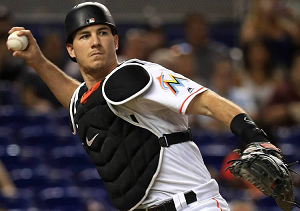 1. Marlins – J.T. Realmuto
1. Marlins – J.T. Realmuto
2. Braves – Tyler Flowers
3. Mets – Travis D’Arnaud
4. Nationals – Matt Wieters/Miguel Montero
5. Phillies – Jorge Alfaro
When anyone with a pulse, and a salary, became Radioactive to the new Marlins ownership, Realmuto became the best position player on the team by default. That doesn’t mean he’s a star, at least not yet, and Flowers had better numbers last season. But Realmuto is five years younger, and is probably better overall. D’Arnaud has disappointed most seasons, but there’s a chance he turns in the best season of the group. As for the rest, I don’t have much faith in Wieters hitting enough, and his defense hasn’t been all the good either the last few years. Montero might hit, although that’s no longer a given, and he’s not much of a defender, either. Alfaro has shown occasional power but probably won’t hit for any sort of average.
SCORE: MIA (5), ATL (4), NY (3), DC (2), PHI (1)
[button url=’#’ size=’small’ style=’red’] FIRST BASE [/button] (Derek and the Dominoes)
 1. Braves – Freddie Freeman
1. Braves – Freddie Freeman
2. Phillies – Carlos Santana
3. Nationals – Ryan Zimmerman/Matt Adams
4. Marlins – Justin Bour
5. Mets – Adrian Gonzalez
To Tell the Truth, I probably overrate Freeman because of how well he plays against the Nats, but I still think he’s gotta remain at the top of this list. Unlike recent years, though, he’s got some competition. Santana can really hit, while he doesn’t have the ability to get on base that Freeman does, he has just as much, if not more power. I don’t think Zim will necessarily repeat his 2017, and health is always a question with him, but once again the Nats management did a good job of finding a backup 1B. Even if Adams has to play 2/3 of the season, the Nats are probably still in pretty good shape there. Justin Bour has gotten better each year, which would be promising if he was 25, but he’ll be 30 this year, so I’m not buying that 2017 wasn’t his high-water mark, especially with his playing time issues. I’m guessing Gonzalez isn’t done, but if he hits .275 with 20 HRs, that would be a nice recovery without necessarily beating any other 1B in the division.
SCORE: ATL (9), MIA (7), DC (5), PHI (5), NY (4)
[button url=’#’ size=’small’ style=’red’] SECOND BASE [/button] (Me First and the Gimme Gimmes)
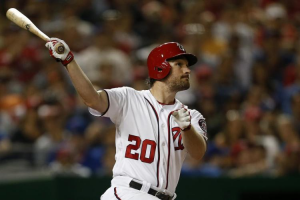 1. Nationals – Daniel Murphy
1. Nationals – Daniel Murphy
2. Phillies – Scott Kingery
3. Braves – Ozze Albies
4. Marlins – Starlin Castro
5. Mets – Asdrubal Cabrera
The only real question here is if Murphy is healthy enough to get over 500 PAs. His offseason microfracture surgery has kept him from being on the Opening Day lineup, although that wasn’t exactly surprising. If he’s back by May, Danny’s Song will lead this group, if not, Murphy could quickly sink down the list, because it’s not a bad group overall. The Phillies promotion of Kingery, a potential 20-20 type who will have to show he can adjust to the majors. Albies was really underrated last year, and is a good hitter. Castro and Cabrera are both pretty solid players – Castro is probably the better hitter, and certainly the better fielder of the two.
SCORE: ATL (12), DC (10), MIA (9), PHI (9), NY (5)
[button url=’#’ size=’small’ style=’red’] THIRD BASE [/button] (Asia)
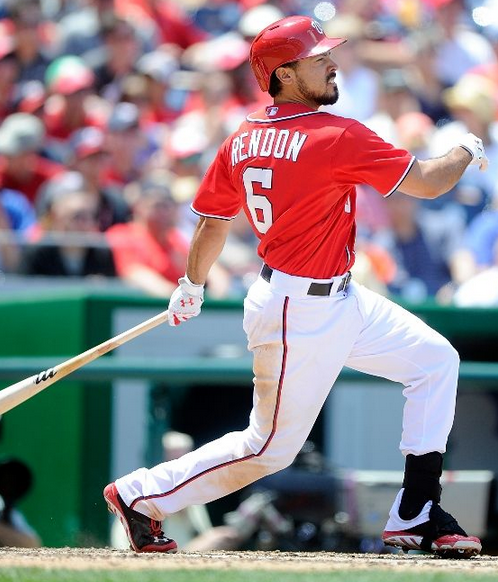 1. Nationals – Anthony Rendon
1. Nationals – Anthony Rendon
2. Mets – Todd Frazier
3. Marlins – Martin Prado
4. Phillies – Maikel Franco
5. Braves – Johan Camargo
Rendon was really good last year. He led the NL in fWAR, and you might get overly excited and, in the Heat of the Moment, suggest he was the best player in the National League. That argument, though, is a bit irrelevant to this discussion, because the rest of the division is not up to his level. Todd Frazier is a really productive player who will be a meaningful addition to the Mets lineup, while the rest of the division isn’t as impressive at third base. Prado was hurt last year, and can probably still hit enough to not be bad, but it might be a stretch to expect much more than that. Franco didn’t turn out to be what we thought when we first saw him, and Camargo is a really weak hitter for the position.
SCORE: DC (15), ATL (13), MIA (12), PHI (11), NY (9)
[button url=’#’ size=’small’ style=’red’] SHORTSTOP [/button] (Cream)
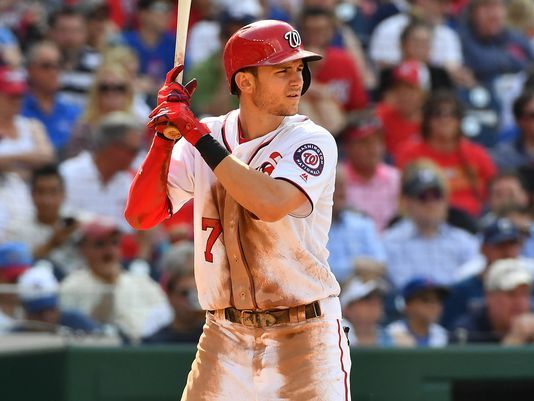 1. Nationals – Trea Turner
1. Nationals – Trea Turner
2. Braves – Dansby Swanson
3. Phillies – JP Crawford
4. Mets – Amed Rosario
5. Marlins – JT Riddle
Youth is served at shortstop in the NL East. Turner is certainly projected to have the best season, but his BP projections of leading the entire Nats team in WARP should probably be taken with a grain of salt, or perhaps even a Spoonful. Skepticism and algorithms overly affected by incredible half seasons aside, he’s still got the potential to be spectacular, and is likely to be the best of this group. Swanson was once the next big thing, and he can hit, although he isn’t a great defensive shortstop. Crawford is really solid defensively, and could hit himself up the list of things go right. Rosario is a defensive shortstop who can’t hit much, same with Riddle except he’s probably worse at both things than Rosario.
SCORE: DC (20), ATL (17), PHI (14), MIA (13), NY (11)
[button url=’#’ size=’small’ style=’red’] LEFT FIELD [/button] (Power Station)
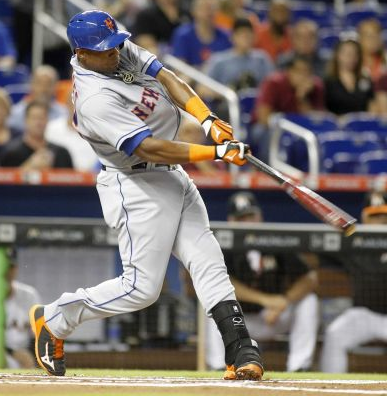 1. Mets – Yoenis Cespedes
1. Mets – Yoenis Cespedes
2. Nats – Adam Eaton
3. Phillies – Rhys Hoskins
4. Marlins – Derek Dietrich
5. Braves – Lane Adams
I don’t really have a clever phrase for this one, or even a very non-clever one. But for some reason I think Yoenis Cespedes deserves to be associated with Power Station’s Some Like it Hot, so there you go. Cespedes is great, but Eaton could sneak up and have a better season. Eaton will have to get on base a ton and demonstrate again that he is a plus plus defender in a corner OF spot, but he’s done both before. Hoskins may end up being such a good enough hitter that I considered putting him above Eaton, but Hoskins is still really young, and while he has eye-popping power, he isn’t much of a defender, even hiding in LF. Deitrich and Adams are both serviceable players but more fourth OF types at this point than what you’d want in a starting left fielder.
SCORE: DC (24), ATL (18), PHI (17), NY (16), MIA (15)
[button url=’#’ size=’small’ style=’red’] CENTER FIELD [/button] (Bad Company)
 1. Braves – Endar Inciarte
1. Braves – Endar Inciarte
2. Mets – Michael Conforto
3. Nats – Michael A Taylor/Victor Robles
4. Marlins – Lewis Brinson
5. Phillies – Odubal Herrera
Inciarte is a really strong defender and, although he has almost no power, he can hit enough to get on base at a decent clip. He’ll need to in order to Run with the Pack here in a balanced if not yet star studded position. Conforto isn’t a great defender out there, but his hitting makes up for it. I probably have him higher ranked than most would, but I like Conforto quite a bit. Taylor seems like a regression candidate, but if he can just repeat last year, the Nats are probably thrilled. If not, they might just bring up Robles who could be a rookie of the year candidate. Meanwhile, Brinson is a legit rookie of the year candidate himself, and if he breaks out early, he could outrank everyone here. Herrera is no slouch, and it demonstrates how much this particular position could flip upside down with a few breaks one way or another.
SCORE: DC (27), ATL (23), NY (20), PHI (18), MIA (17)
[button url=’#’ size=’small’ style=’red’] RIGHT FIELD [/button] (Traveling Wilburys)
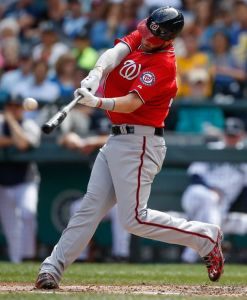 1. Nats – Bryce Harper
1. Nats – Bryce Harper
2. Mets – Jay Bruce
3. Marlins – Cameron Maybin/Garrett Cooper
4. Braves – Nick Markakis/Ronald Acuna
5. Phillies – Nick Williams/Aaron Altherr
Nats fans hope this isn’t The End of Line for Harper in Washington, but even if it is, everyone is expecting big things from him. A guy who seems to like the big moments and the big stage might have a monster year as his contract ends. The fact that I have Jay Bruce listed second here isn’t an indication of how good Bruce is (well, ok it is, but), instead it’s an indication of how weak this position is outside of Harper. You could probably easily switch around the order of the last three on this list and not get an argument from me, so I’m not going to dive deeply into what I think of each one, other than a universal “they’re not that good.” Ok Nick Williams might end up being a good hitter, but I’m not there yet with him.
SCORE: DC (32), ATL (25), NY (24), MIA (20), PHI (19)
The Nats seem to have the best lineup, far and away. The rest of the division is pretty bunched together, which suggests that despite a few acquisitions, the Mets weren’t able to put together a lineup that could stand out from the rest of the pack. It also shows that the other teams in the division are beginning to catch up. Most surprising to me was the Phillies – the story of the offseason was that they improved their lineup. And believe me, they did, but probably not enough to catch up to the better teams. Atlanta, on the other hand, does have some decent offensive capabilities.
Next, we’ll look at the pitching, to see if the Nats have enough to keep them on top, how far the Mets rotation can bring them up on the list, and if any of the other three have the pitching staff that makes them appear competitive.

